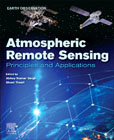
Atmospheric Remote Sensing: Principles and Applications
Kumar Singh, Abhay
Tiwari, Shani
Atmospheric Remote Sensing: Principles and Applications begins with a comprehensive discussion of the fundamental principles of atmospheric remote sensing and their applications in different research domains. Furthermore, in detail, it covers the basic concepts of satellite remote sensing of the atmosphere, followed by the Ionospheric remote sensing tools like Global Positioning System (GPS), and Very Low Frequency (VLF) wave. It also emphasizes the applications of atmospheric remote study in Ionospheric perturbation, fire detection, aerosol characteristics over the land, ocean, and Himalayan region. In addition, the application of atmospheric remote sensing in disaster management like dust storms, cyclones, smoke plume, aerosol-cloud interaction, and their impact on climate change is also discussed in the book. Atmospheric Remote Sensing: Principles and Applications is a valuable reference for students, researchers and professionals working in atmospheric science, remote sensing, and related disciplines. Covers the fundamentals of remote sensing as applied to atmospheric science Includes methods and applications of remote sensing technologies for atmospheric science and related disciplines in earth science Includes full color photographs and figures to visually represent the concepts discussed in the book INDICE: Section 1: Principles of atmospheric remote sensing 1. Satellite Remote Sensing Aerosol Optical Depth (AOD) Retrievals: accuracy assessment, limitations, and usage recommendations over Asia 2. Earth Observation Satellites (EOS) for global sustainability: Potentials and boundaries 3. Remote Sensing and its implication to air pollution studies 4. Global Navigation Satellite System and its Application in Remote Sensing of Atmosphere 5. Estimation of Ionospheric Total Electron Content (TEC) from GNSS observations 6. Impact of water vapor on atmospheric correction of satellite images Section 2: Application of atmospheric remote sensing 7. Identification of fires over the Indian region from space 8. Identification of different aerosol types observed at a semi-arid location in southern peninsular India retrieved from the CALIPSO 9. Remote sensing of clouds: challenges and way forward 10. Study of Aerosol - Cloud Interaction over Indian region using satellite remote sensing 11. Aerosol loading over the Northern Indian ocean using spaceborne measurement 12. Balloon - based remote sensing of Atmosphere 13. Vertical distribution of atmospheric brown clouds using LiDAR remote sensing over Indian region 14. Application of Remote Sensing to study forest fires over the Himalayan region 15. Study of the atmospheric and ionospheric phenomenon using GPS based remote sensing technique 16. Low-latitude lower ionosphere remote sensing using very low frequency (VLF) waves 17. Remote Sensing of Ionosphere, Plasmasphere, and Magnetosphere by VLF Wave 18. Remote Sensing of Ionospheric Irregularities 19. Application of atmospheric remote sensing in disaster management 20. Characteristics of tropical cyclones through remote sensing observations and techniques 21. Significance of Remote sensing in Tropical Cyclone prediction and disaster management: Indian perspective 22. Study of dust storm characteristics over Indo - Gangetic Basin through satellite remote sensing 23. Geomorphological mapping of glacial and periglacial landforms using Remote Sensing: Examples from semi-arid and sub-humid Himalayan valleys 24. Classification of Remotely sensed Formosat-2 Haridwar data using Deep Learning Artificial Neural Network and Convolutional Neural Network 25. Remote sensing-based study of landslide hazard zonation in Namchi and its surrounding area of Sikkim, India
- ISBN: 978-0-323-99262-6
- Editorial: Elsevier
- Encuadernacion: Rústica
- Páginas: 350
- Fecha Publicación: 01/11/2022
- Nº Volúmenes: 1
- Idioma: Inglés
